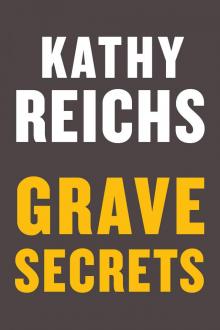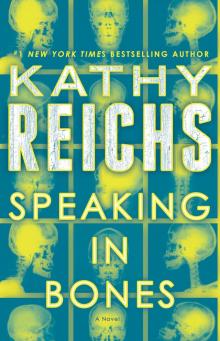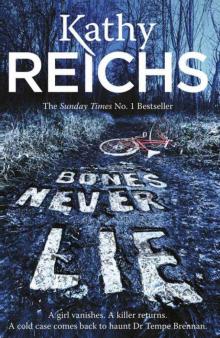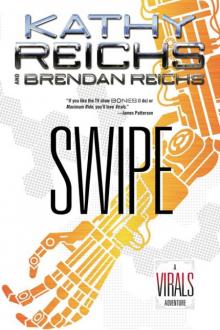- Home
- Kathy Reichs
Deadly Decisions Page 8
Deadly Decisions Read online
Page 8
“For the past few days I’ve done nothing but chase down leads to show that he didn’t do it. Anything. Anyone. All I wanted was one tiny hint of doubt.”
When he gestured with thumb and index finger, I could see a tiny tremor in his hand.
“It wasn’t there, Tempe.” He ran a hand over his face. “But it doesn’t matter anymore.”
“It does matter. It’s the only thing that matters.”
“At first I thought, no way. Not Andrew Ryan. Then I learned the case against him.”
He took another deep breath.
“Look, Tempe, I’m sorry. I’m so sorry for this whole goddam mess I’m not sure who I am anymore or where the world’s going. And I’m not sure if it’s worth the price of a ticket to ride.”
When I looked up Bertrand’s face was filled with pain, and I knew exactly what he was feeling. He was trying not to despise his partner for succumbing to the greed, all the while hating him for the deep, cold emptiness his betrayal had created.
Bertrand promised to let me know if he learned anything. When he left I trashed the fish and cried myself to sleep.
THURSDAY I PUT ON A DARK BLUE SUIT AND DROVE TO OUR LADY of the Angels. The morning was blustery, the sun appearing only infrequently among the heavy clouds scudding across the sky.
I parked and threaded through the usual collection of gawkers, journalists, and cops. No sign of Charbonneau, Claudel, or Quick-water.
Of the trickle of mourners solemnly climbing the steps, most were black. Whites arrived in couples or groups, each with at least one child in tow. Probably Emily Anne’s classmates and their families.
Near the entrance, a wind gust tore the hat from the head of an old woman to my right. One gnarled hand flew to her head while the other fought the skirt whipping round her legs.
I darted forward, trapped the hat against the church wall, and handed it to the woman. She clutched it to her bony chest and gave a small smile. Her wrinkled brown face reminded me of the crab-apple dolls crafted by ladies in the Smoky Mountains.
“You be a frien’ of Emily Anne?” the old woman asked in a crackly voice.
“Yes, ma’am.” I didn’t want to explain my involvement.
“She my gran’chile.”
“I am so sorry for your loss.”
“I got twenty-two gran’children, but that Emily Anne be somet’ing special. That chile do everyt’ing. She writes her letters, she does dance ballet, she does swim, she does skate on ice. I t’inking that girl be even smarter than her mama.”
“She was a beautiful little girl.”
“Maybe that be why God take her up.”
I watched Emily Anne’s grandmother totter on, remembering those same words from a long time ago. A slumbering ache stirred in my chest, and I steeled myself for what was to come.
Inside, the church was cool and smelled of incense and wax and wood polish. Light filtered through stained glass, casting a pastel softness over everything.
The pews were packed in front, with a scattering of attendees in the middle. I slipped into a back row, folded my hands, and tried to concentrate on the present. Already my skin itched and my palms felt sweaty. As I looked around, the organist finished one requiem and began another.
A miniature white casket sat below the altar, heaped with flowers and flanked by candles at either end. Balloons bobbed on strings attached to the coffin’s handles. The brightly colored spheres looked jarringly out of sync with the scene.
In the front pew I could see two small heads, a larger figure between them. Mrs. Toussaint was bent forward, a handkerchief clutched to her mouth. As I watched, her shoulders began to heave, and a tiny hand rose and gently rubbed her upper arm.
The dormant ache within me awoke fully, and I was back at St. Barnabas parish. Father Morrison was at the pulpit and my little brother lay in his own tiny coffin.
My mother’s sobs were terrible, and I reached up to comfort her. She did not acknowledge my touch, just held little Harriet to her chest and cried onto her head. Feeling utterly helpless, I watched my sister’s corn-silk hair grow damp with my mother’s tears.
If I had been given a box of crayons and asked to draw my world at six, I would have chosen a single color. Black.
I’d been powerless to save Kevin, to stop the leukemia devastating his tiny body. He was my most treasured gift, my Christmas brother, and I adored him. I had prayed and prayed, but I could do nothing to prevent his death. Or to make my mother smile. I had begun to wonder if I were evil, because my prayers were of no effect.
Almost four decades, and the pain of Kevin’s death still lingered. The sights and sounds and smells of a funeral Mass never failed to reopen that wound, allowing the buried grief to ooze into my conscious thought.
I moved my eyes from the Toussaint family and scanned the crowd. Charbonneau had concealed himself in the shadow of a confessional booth, but I recognized no one else.
At that moment the priest entered and crossed himself. He looked young, athletic, and nervous. More like a tennis player approaching a match than a priest approaching a funeral service. We all stood.
As I went through the familiar motions, my skin felt flushed, my heart beat faster than it should have. I tried to concentrate, but my mind resisted. Images bled into my brain, taking me back to that time in my childhood.
An enormous woman took the pulpit to the right of the altar. Her skin was the color of mahogany, her hair braided atop her head. The woman’s cheeks glistened as she sang “Amazing Grace.” I remembered her from the newspaper photo.
Then, the priest spoke of childhood innocence. Relatives praised Emily Anne’s sunny disposition, her love of family. An uncle mentioned her passion for waffles. Her teacher described an enthusiastic student, and read the essay that had won a prize. A classmate recited an original poem.
More hymns. Communion. The faithful filed up, returned to their seats. Stifled sobs. Incense. The blessing of the coffin. Soft wailing from Mrs. Toussaint.
Finally, the priest turned and asked Emily Anne’s sisters and classmates to join him, then seated himself on the altar steps. There was a moment of absolute stillness, followed by whispered commands and parental nudging. One by one children emerged from the pews and walked timidly toward the altar.
What the priest said was not original. Emily Anne is in heaven with God. She has been reunited with her father. One day her mother and sisters will join her, as will everyone present.
What the young priest did next was original. He told the children that Emily Anne was happy, and that we should celebrate with her. He signaled his servers, who disappeared into the vestry, and returned with huge bunches of balloons.
“These balloons are filled with helium,” explained the priest. “That makes them fly. I want you each to take one, and we will all walk out with Emily Anne. We will say a good-bye prayer, then release our balloons to rise to heaven. Emily Anne will see them and know that we love her.”
He looked at the solemn little faces.
“Is that a good idea?”
Every head nodded.
The priest rose, disentangled strings, placed a balloon in each small hand, and led the children down the steps. The organist began Schubert’s “Ave Maria.”
The pallbearers came forward, lifted the casket, and the procession moved toward the door, the pews emptying in its wake. As the line passed, I slipped in at the end.
The mourners followed the coffin outside then circled around, children on the inside, adults forming an outer ring. Mrs. Toussaint stood behind her daughters, supported by the singer.
I held back on the steps. The overcast had broken, leaving a sky filled with tumbling white clouds. As I watched balloons rise toward them, I felt a grief as sharp as anything I’d felt in my life.
I lingered a moment, then descended slowly, wiping tears from my cheeks, and reaffirming the vow I’d made on the day of Emily Anne’s death.
I would find these indiscriminate butchers and put them where th
ey could never kill another child. I could not restore the daughter but I would provide this small comfort for the mother.
Leaving Emily Anne to those who loved her, I drove toward Parthenais, in a mood to lose myself in work.
• • •
At the lab, the Carcajou investigators already had names for the skeletons from St-Basile. Félix Martineau, age twenty-seven, and Robert Gately, age thirty-nine, rode with the Tarantulas, a now defunct OMC, but active in Montreal in the seventies and eighties. Gately was a full patch member, Martineau a prospect.
On the evening of August 24, 1987, the two had left Gately’s apartment on rue Hochelaga heading for a party. Gately’s ole lady did not know the name or address of the host. Neither man was seen again.
I spent the day with the bones from the double burial, sorting them into individuals and determining age, sex, race, and height. Cranial and pelvic shape confirmed both victims were male. The differences in age and height made the task of individuation considerably easier than with the Vaillancourt brothers.
As soon as I’d finished with the skulls and jaws I’d given them to Marc Bergeron for odontological analysis. I figured his job would be easy too, since both men had obvious dental work.
The taller victim had a well-healed fracture of the collarbone. I was photographing the injury when Bergeron entered my lab Friday morning. The dentist was one of the oddest-looking men I’d ever met, with wild, dandelion hair and a daddy-longlegs build. It was impossible to guess his age, and no one at the lab seemed to know.
Bergeron waited until I’d snapped the shot then confirmed the identifications as positive.
“How did you get the records so quickly?”
“Two very cooperative dentists. And, fortunately for me, the deceased had a commitment to oral health. At least Gately did. Bad teeth, lots of restorations. Martineau was less fastidious, but there were some peculiarities that made him a cinch. The big bad biker was walking around with four baby teeth in his mouth. That’s pretty rare for someone his age.”
I turned off the lights on the copy stand.
“Have you started on the third victim?” Bergeron asked.
“Not yet, but I can finish this later. Shall we take a look?”
I’d been wanting to look at the third set of bones all morning and Bergeron provided a good excuse.
“You bet.”
I returned the collarbone to the skeleton on the left side of my worktable.
“Who’s who?” I asked, gesturing at the bones.
Bergeron went to his tray and checked the digits on each occipital bone, then those on the small cards I’d set beside the skeletons, and positioned the skulls accordingly. He swept a bony arm over the victim with the broken clavicle.
“Monsieur Martineau.”
Then over the gentleman on his right.
“And Mr. Gately.”
“Was Gately an Anglophone?”
“I assume so since his dentist doesn’t speak a word of French.”
“Not too many of those among les motards.”
“None that I know of,” Bergeron agreed.
“Will you give the good news to Quickwater and Claudel?”
“I’ve already made the call.”
I went to the storage shelves and pulled the box containing the third St-Basile victim. Since the remains were coated with dirt, I placed a screen in the sink, set them in it, and ran warm water over them.
The long bones cleaned easily, so I laid them on the drainboard and began brushing mud from the outside of the skull. Its weight told me that the cranial interior was packed solid. When the facial features were clear I inverted the skull and let the tap water run over the base. Then I crossed to my desk to fill out a case identification card.
When I returned to the sink Bergeron held the skull in his hands, turning it faceup, then rotating it for a lateral view. He stared at the features a long time then said, “Oh my.”
When he handed me the cranium I repeated his movements, then echoed his thought.
“Oh my.”
ONE LOOK AND I KNEW I’D BEEN WRONG. THE SMOOTH FOREHEAD and occiput, slender cheekbones, and small mastoid processes told me that bachelor number three was clearly of my own gender.
I got my calipers and took a measurement from one of the bones that lay on the drainboard. The femoral head is a ball-like structure that fits into a socket in the pelvis to form the hip joint. This one had a diameter of only thirty-nine millimeters, placing it squarely in the female range.
And the victim had been young. I could see a jagged line across the top of the ball, indicating that fusion of the growth cap was incomplete at the time of death.
I returned to the cranium. Squiggly lines separated all the bones. I rotated the skull for a view of the base. Just in front of the foramen magnum, the hole through which the spinal cord leaves the brain, there was a gap between the sphenoid and occipital bones.
I showed Bergeron the open suture.
“She was just a kid,” I said. “Probably in her teens.”
He made a comment, but I didn’t hear. My attention had been drawn to an irregularity on the right parietal bone. Cautiously, I ran my fingers over it. Yes, there was something there.
Taking care to cause no damage, I held the skull under the faucet and teased away dirt with a soft-bristle toothbrush. Bergeron watched as the defect came into focus. It took only moments.
What I’d spotted was a small round hole, slightly above and behind the ear opening. I estimated its diameter at approximately one centimeter.
“Gunshot wound?” Bergeron suggested.
“Maybe. No. I don’t think so.”
Though the proper size for a small-caliber projectile, the perforation didn’t look like a bullet entrance. Its border was smooth and rounded, like the inside of a doughnut hole.
“Then what?”
“I’m not sure. Maybe some type of congenital defect. Maybe an abscess. I’ll know better when I empty the skull and get a look at the endocranial surface. I’ll also need X rays to see what’s going on inside the bone.”
Bergeron looked at his watch.
“Let me know when you’ve finished so I can shoot some bite-wings on this one. I didn’t see any restorations, but I might spot something on the X rays. The right canine has an odd alignment which will be useful, but I’d prefer having the lower jaw.”
“I’ll work harder next time.”
“Not necessary.” He laughed.
When Bergeron left I set the skull upside down in a rubber ring and adjusted the water so it ran gently into the foramen magnum. Then I went back to photographing Gately and Martineau, documenting skeletal features relevant to their identifications. I also took multiple shots of the bullet holes in the back of each man’s head.
Periodically I checked the unknown female’s skull, pouring off muck as the water loosened it. Just before noon, as I was draining sediment, something broke free and tapped against the cranial interior. I placed the skull back on the ring and slipped my fingers inside.
The object felt long and thin. I tried to dislodge it, but the thing had a tail of some sort still embedded in the mud. Barely able to contain my curiosity, I adjusted the tap and went back to the Gately report.
By 1 P.M. the object floated free, but the trailer was still firmly cemented. Impatient, I allowed the sink to fill, immersed the skull, and went downstairs to the cafeteria.
When I returned from lunch the soaking had liquefied the last of the dirt, and I was able to pour it off easily. Holding my breath, I inserted my fingers and delicately manipulated the object free.
The device was less than four inches long, and consisted of a length of tubing with a valve at one end. I cleaned it and placed it on a tray. Certain of its importance, but unsure as to what it was, I washed my hands and went in search of a pathologist.
According to the duty board, LaManche was at a meeting of the committee on infant mortality. Marcel Morin was at his desk.
He loo
ked up when I tapped on the door.
“Got a minute?”
“But of course.” His French was warm and lyrical, reflecting the Haiti of his boyhood. I entered the office and placed the tray in front of him.
“Ah. A surgical implant.” His eyebrows rose behind rimless glasses. They were graying, like the tightly cropped frizz of hair retreating backward on his scalp.
“I thought so. Can you tell me more about it?”
He lifted both palms. “Not much. It looks like a ventricular shunt, but I’m not a neurosurgeon. You might want to talk to Carolyn Russell. She’s done some neuro consults for us.”
He flipped through his Rolodex, jotted down a number, and handed it to me, saying, “She’s at the MNI.”
I thanked him, went to my office, and dialed the Montreal Neurological Institute. Dr. Russell was in a meeting, so I left a message. I’d just hung up when the phone rang. It was Claudel.
“You’ve talked to Bergeron?” he asked.
“He just left.”
“So two make the jump from the list of missing to the list of dead.”
I waited for him to go on, but he didn’t.
“And?”
A Claudel pause, then, “We’ve started making calls, but no one knows a thing. Not surprising, given the fact that more than a decade has passed and these people aren’t geographically stable. Of course they wouldn’t tell us spit if we’d hauled their grandmothers out of that hole.”
“What about Rinaldi?”
“Frog’s sticking to his story. He knew what he knew by word of mouth. According to club lore Gately and Martineau went to a party and walked right in on their own funeral.”
“In stocking feet.”
“Right. These fellows tend to underdress. But Frog wasn’t there when the hit went down. It was probably his night for charity work. What about the third guy?”
“The third guy is a girl.”
“A girl.”
“Yes. What does Frog know about her?”
“Not a thing. But Frog would give nothing up if there wasn’t a prize in it for him. What can you tell me about her?”
“She was a white female in her mid to late teens.”

 Two Nights
Two Nights The Bone Collection: Four Novellas
The Bone Collection: Four Novellas Fatal Voyage
Fatal Voyage 206 Bones
206 Bones Bones to Ashes
Bones to Ashes Terminal
Terminal Monday Mourning
Monday Mourning Flash and Bones
Flash and Bones Cross Bones
Cross Bones Devil Bones
Devil Bones Break No Bones
Break No Bones Swamp Bones
Swamp Bones Déjà Dead
Déjà Dead Shock
Shock Spider Bones
Spider Bones Death Du Jour
Death Du Jour Grave Secrets
Grave Secrets Trace Evidence: A Virals Short Story Collection
Trace Evidence: A Virals Short Story Collection Bones on Ice
Bones on Ice The Bone Code
The Bone Code Bones in Her Pocket
Bones in Her Pocket Seizure:
Seizure: Speaking in Bones
Speaking in Bones Deadly Decisions
Deadly Decisions Spike
Spike Bones Never Lie
Bones Never Lie Bones of the Lost
Bones of the Lost Virals 03.5 - Swipe
Virals 03.5 - Swipe Exposure
Exposure A Conspiracy of Bones
A Conspiracy of Bones Shift (tory brennan)
Shift (tory brennan) Bones of the Lost: A Temperance Brennan Novel tb-16
Bones of the Lost: A Temperance Brennan Novel tb-16 Virals tb-1
Virals tb-1 Bones Are Forever tb-15
Bones Are Forever tb-15 Code tb-3
Code tb-3 Seizure tb-2
Seizure tb-2 Deadly Descisions
Deadly Descisions Spider Bones: A Novel
Spider Bones: A Novel